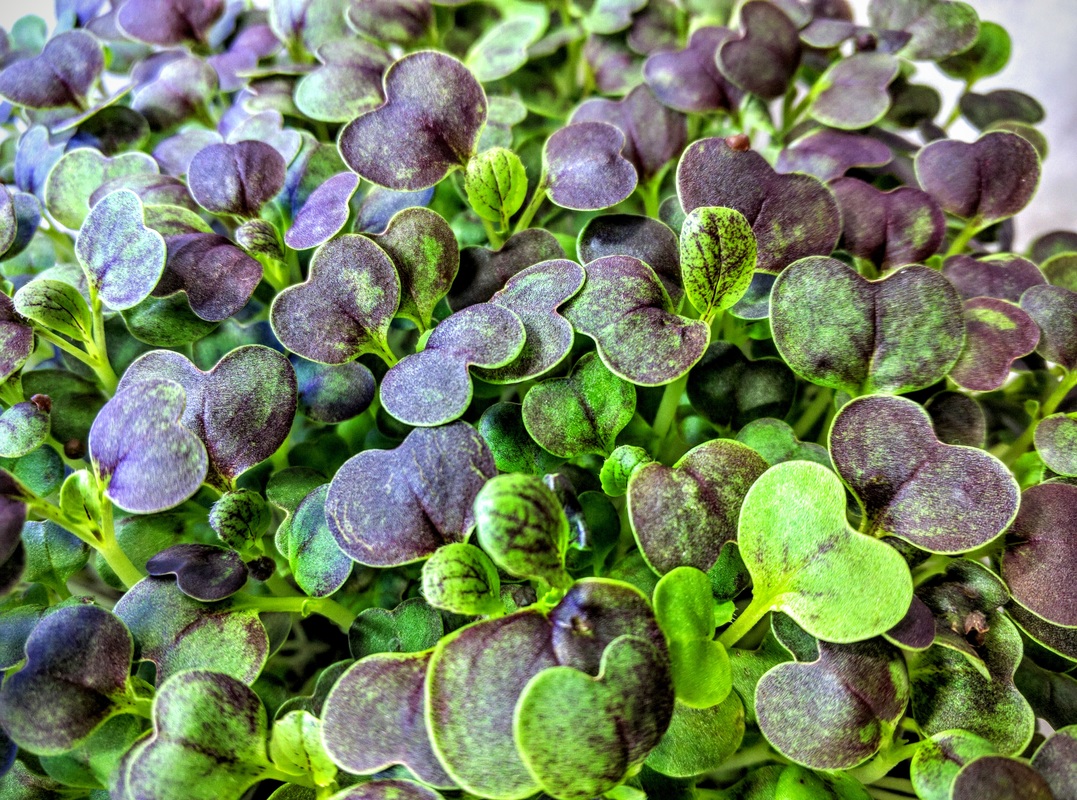 Building on our last posting, we have isolated a couple more instances of spectacular purple examples from the microgreen fields. One of my absolute favorites is the spectacular Purple Magic Pak Choi that we first posted in our last post. Today we have a closeup view (see above) of the absolutely magical true leaves that have emerged at 2 weeks time. Both of the pak chois shown last post have deep purple highlights and great tastes. These impressive hybrids provide visual and flavor accents without parallel. Our second purple highlight is our Rambo Radish that is typically grown out in 1 week vs the 2 for the pak chois. The Rambo is significantly larger and more robust with a nice tangy flavor. Both of our purple microgreens have an abundance of wonderful nutritional benefits while adding a zing to your creations. We have two more new seeds that are growing out and will be presented next week. Our first kit featuring three purple seeds is now available in our etsy store. We are going to be unveiling a new site dedicated to our nutritional offerings. Watch for the announcement shortly!
0 Comments
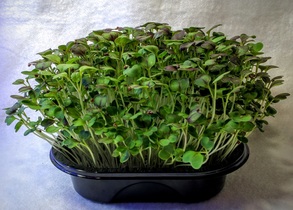 Da Hong Pak Choi at 12 days Da Hong Pak Choi at 12 days Some little known compounds called Anthocyanins are basically what gives color (purples, reds, blues) to fresh vegetables and fruits. These powerhouses have been shown to have effect on cardiovascular disease, cancer, and cognitive function. Research so far has been promising, but there is much more to be done. We have started isolating crops with color for our kits and production to take advantage of this compound in addition to the already present traits of the underlying plant. Red Cabbage is one of the most nutrient dense microgreens available and is a starting point for our search. We have found and grown now several new addtions to our lineup and will be adding them to our kits for home growing. The pictures today are two Pak Choi varieties that sport spectacular colors; purple magic and da hong. Note the delicate coloration of these unique microgreens. 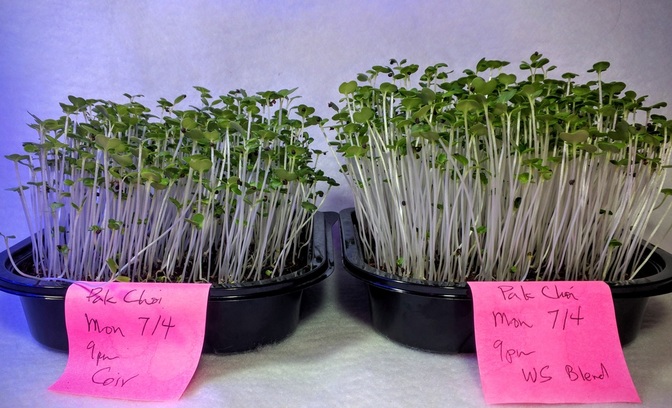 Plain coir on left with Wonder Soil Microgreen blend on right Plain coir on left with Wonder Soil Microgreen blend on right In our original blog on the testing of our newly blended growing media, it was pointed out that there should have been a control item to establish a baseline performance by which to judge the effectiveness of our Wonder Soil custom blend. So we have now taken a test of the blend versus just coir to do that. In our first test we showed the difference of our added trace minerals to the performance of our custom blend (compressed coir, worm castings and kelp). It showed the effectiveness of the trace mineral addition, so today's update charts how our blend (w/o trace minerals) fares against just the coir. Microgreens are normally harvested in a very short growing cycle (experiment today is approx 9 days from seed to harvest). We used pak choi seeds from the same lot and planted them in similar containers and media depth. Normal germination of approx 4 days before putting the plants under our new blue/red LED array to grow out to the conclusion of our experiment with both trays receiving the same amount of light. You can see the difference in the pak choi microgreens in that short of a time. BUT there was an even bigger surprise that we discovered next. Here is a picture from the bottom of the trays. I normally take my expended media and seeds and plant them outside on our hill. As I took the trays out and removed the media, look what had been going on below the plants. The left again is the plain coir and the right is the extreme root mass that was curled around at the bottom of the tray! The plants growing in our custom blend are not only healthy but are absorbing a ton more nutrients in the process. The extreme difference in roots also explains how the first test showed a significant step up in size and weight of the plants. All of this amazing growth happening in just 9 short days!
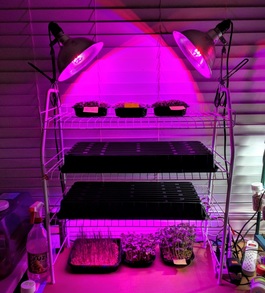 Following up on our last update on lighting for growing microgreens. We have now updated our test bench to include a solid blue LED source. We are conducting experiments using both the Red/Blue and pure Blue LED arrays. The red or purple coloration in plants is attributed to anthocyanin pigments which gives them this color. Anthocyanins in addition to visual dramatics, has had promising research studies showing help with vision, anti cancer properties, inflammation, provides anti oxidants, can help with diabetes and obesity along, cognitive function and others. 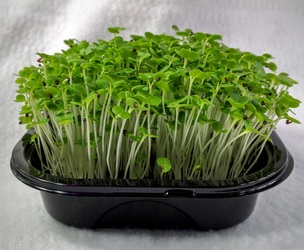 Growing any crop requires juggling light, water and nutrients. We have examined lighting and irrigation so let’s look at the third variable, nutrients. Microgreens are unique because the seeds themselves provide the initial kick of nutrients, but growth can be enhanced with additional nutrient sources in the “soil”. It was with this in mind that we tested multiple types of growing media. We have tried using hydroponic mats, fiber mats, coco coir, potting soil, sterile mats, cloth mats, and baby blankets. It is our mission to grow organic seeds in media that was also organic. Several years ago we were introduced to Wonder Soil, compressed coir made in Las Vegas, USA. We had great success using the media, so we asked if a specialized mix could be made that was tailored to microgreens. What we came up with was a mix of worm castings and kelp, natural sources of organic nutrients that are both sustainable and potent. We have been using this mix with great success and are now introducing trace minerals into the mix with the addition of SEA-90, sea solids from SeaAgri. These trace minerals have proved to be extremely beneficial for our plants, so we asked the Wonder Soil folks to incorporate the SEA-90 product into our wafers, to produce an enhanced growing media for our microgreens. These are the results from our first experiment using pak choi microgreens grown in our normal mix and compared to the new mix with the SEA-90 trace minerals. We grew the microgreens just 8 days before harvesting. Our custom Wonder Soil mix was already an excellent growing media, but we wanted to see how much difference the inclusion of trace minerals would make. At the beginning of the experiment there appeared to be little difference in growth. Later, we found that this was due to the different heights of the soil. When we measured from the soil to the tops, we found that the plants with the sea solids were 20% taller, at 75mm vs 63mm. When we compared the weights of 10 cuttings from each tray, there was also a difference of 35% in weight, 62g vs .46g. We will be doing further testing in the coming weeks and will offer our new growing media soon. Watch for announcements and benefit from our research to grow simply the best microgreens available!
|
UrbaformUrbaform is a technology integrator and developer specializing in food production in the urban environment ... Archives
February 2020
Categories |









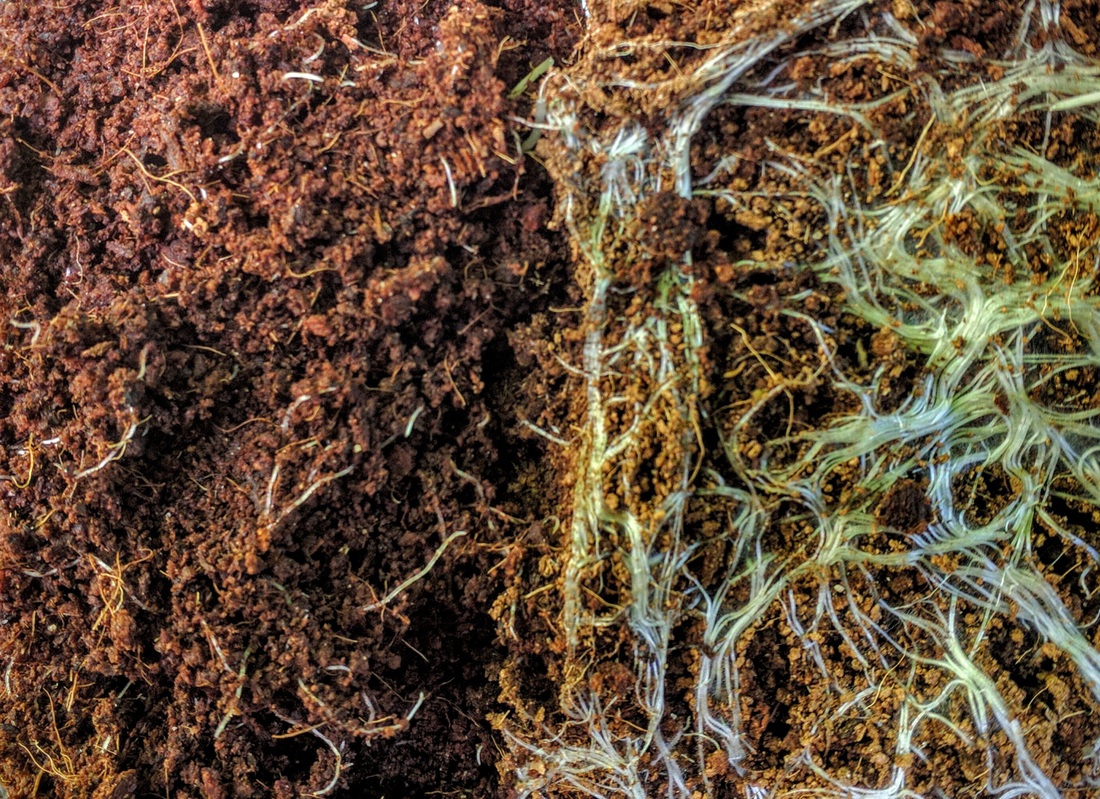














 RSS Feed
RSS Feed